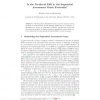Free Online Productivity Tools
i2Speak
i2Symbol
i2OCR
iTex2Img
iWeb2Print
iWeb2Shot
i2Type
iPdf2Split
iPdf2Merge
i2Bopomofo
i2Arabic
i2Style
i2Image
i2PDF
iLatex2Rtf
Sci2ools
GECCO
2004
Springer
2004
Springer
Is the Predicted ESS in the Sequential Assessment Game Evolvable?
The Sequential Assessment Game model of animal contests predicts an evolutionarily stable strategy (ESS) that is a sequence of thresholds for giving up. Simulated evolution experiments reveal that the selection pressure on higher-numbered thresholds is most likely too low to allow for the theoretically predicted ESS to evolve in nature. 1 Simulating the Sequential Assessment Game In game-theoretic models of animal contests, contestants are treated as players whose objective is to maximize their expected number of offspring. A strategy is a prescription of how a player should behave in every possible situation. A strategy S is evolutionarily stable, or an ESS, if a population of players that all follow S cannot be invaded by a mutant strategy S [2]. Being an ESS is only a necessary condition for a strategy to actually evolve. Simulated evolution can be used to investigate whether theoretically predicted ESS’s are indeed evolvable. The objective in the classical Sequential Assessment ...
| Added | 01 Jul 2010 |
| Updated | 01 Jul 2010 |
| Type | Conference |
| Year | 2004 |
| Where | GECCO |
| Authors | Winfried Just, Xiaolu Sun |
Comments (0)

